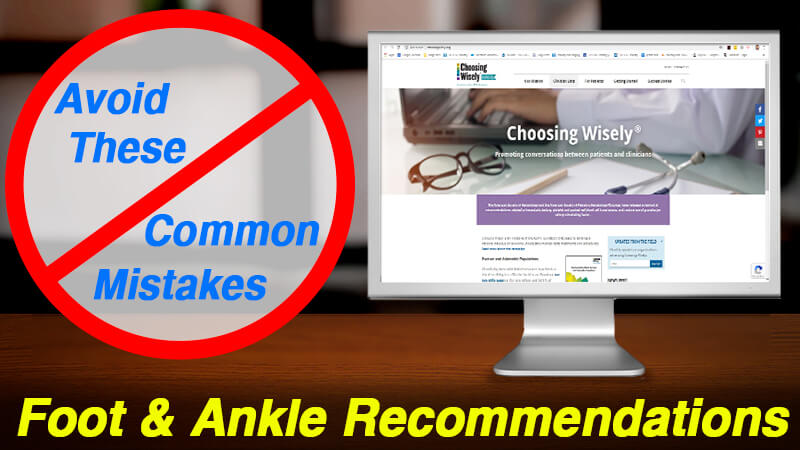
Practice Perfect 686
Avoid These Common Mistakes
Part 1: In Your Foot & Ankle Practice
Avoid These Common Mistakes
Part 1: In Your Foot & Ankle Practice

One of the challenging aspects of clinical practice in today’s society is our patients’ use of the Internet to acquire information about their illnesses. It’s no longer rare for a provider to meet a new patient in the office who thinks they not only know their diagnosis (they usually find something rare, severe, and unlikely) but also how to treat it. I’ve had patients suggest treatments for common disorders like plantar fasciitis with homeopathic remedies, copper coins in the shoes, and magnets. It’s highly common for patients to have already tried over the counter inserts of varying poor quality when they present to my office. The Internet has wonderful uses and is greatly beneficial to society, but it also has the downside of aggregating a ton of garbage information that the average patient is unable to understand and unwilling to discard.
I was excited, then, to come across the Choosing Wisely Campaign (choosingwisely.org). This is a service of the American Board of Internal Medicine (ABIM), partnering with various professional medical societies around the United States. Their mission is to “promote conversations between clinicians and patients1” by providing evidence-based recommendations covering a large number of conditions. My congratulations go out to the American Podiatric Medical Association (APMA) for participating and providing recommendations to the Choosing Wisely Campaign.
Clearly, their philosophy is to promote avoidance of healthcare resource overutilization, so keep in mind these are not clinical practice guidelines – taking the form of “what to do” – but rather behaviors to avoid and “what not to do.” There are literally hundreds of topics available for further reading in a 245-page document2, so I’m going to hit on 10 self-selected ones most pertinent to the care of the lower extremity. I’ll make a few comments at the end for those who are interested. The recommendations are all quoted directly from their resources. Let’s get right to it…
The first five excellent recommendations listed in the Foot and Ankle section below are from the American Podiatric Medical Association, and the second five are from the American Orthopedic Foot & Ankle Society.
Foot and Ankle Recommendations
- Avoid routine use of pharmacologic DVT prophylaxis in elective foot and ankle surgery.
- Don’t culture or treat clinically uninfected lower extremity wounds with systemic antibiotics.
- Avoid ordering MRI in patients with suspected acute Achilles tendon ruptures.
- Don’t use synthetic or donated grafts on diabetic foot wounds without first allowing for an adequate trial of standard wound care.
- Don’t routinely use MRI to diagnose bone infection (osteomyelitis) in the foot.
- Don’t perform surgery for a bunion or hammertoes without symptoms.
- Don’t use shoe inserts for symmetric flat feet or high arches in patients without symptoms.
- Don’t perform surgery for plantar fasciitis before trying six months of non-operative care.
- Avoid X-ray evaluation of the foot and ankle without standing (weightbearing) in the absence of injury.
- Don’t use alcohol injections for Morton’s neuromas.
Final Comments
I couldn’t agree more with the five recommendations from the APMA (the first five recommendations). Great choices on important topics! Clinical signs of infection should always be present when prescribing antibiotics, and it’s up to us to educate others to consider infection as a clinical diagnosis. This same thing is true with MRI for osteomyelitis. I’ve written on this in Practice Perfect 645 MRI to Diagnose Osteomyelitis – Know the Details. The five recommendations from the AOFAS are run-of-the-mill, obvious, and frankly uncreative. Everyone knows these, and other than obtaining weightbearing radiographs (primary care docs still like to order nonweightbearing films) they really don’t need much discussion. I disagree with the recommendation against alcohol injections for neuromas. This remains a viable and potentially successful treatment option. The research for or against sclerosing alcohol is not particularly strong, so I would have left out this recommendation.
In next week’s issue of Practice Perfect, we’ll discuss some of the recommendations from the medicine side of things. For those of you interested in reading about these in greater depth, take a look at the reference or download the ABIM Choosing Wisely iPhone App or Android App and see what NOT to do.

-
Mission Statement. Choosing Wisely. https://www.choosingwisely.org/our-mission/. Updated 2019. Last accessed Dec 14, 2019.
Follow this link -
Choosing Wisely Recommendations. http://www.choosingwisely.org/clinician-lists/. Updated 2019. Last accessed Dec 14, 2019.
Follow this link






























Comments
There are 0 comments for this article